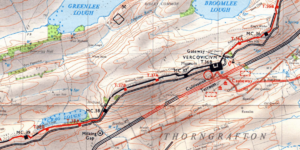Housesteads Roman Fort facts for kids
Quick facts for kids Housesteads Roman Fort |
|
|---|---|
 |
|
| Lua error in Module:Location_map at line 420: attempt to index field 'wikibase' (a nil value). | |
| Alternative name(s) | Vercovicium, Borcovicium |
| Abandoned | c. 400 AD |
| Attested by | Notitia Dignitatum |
| Place in the Roman world | |
| Province | Britannia |
| Structure | |
| — Stone structure — | |
| Built | c. 124 AD |
| Stationed military units | |
| — Legions — | |
| Legio II Augusta | |
| — Cohorts — | |
| Cohors I Tungrorum | |
| Location | |
| Town | Hexham |
| County | Northumberland |
| Country | England |
| Reference | |
| UK-OSNG reference | NY789687 |
| Website | Housesteads Roman Fort |
Housesteads Roman Fort is an ancient Roman fort in Northumberland, England. It was part of Hadrian's Wall, a huge barrier built by the Romans. The fort sits on a high, rocky ridge called the Whin Sill. This location gave it a great view over the surrounding hills.
Many people consider Housesteads to be the "grandest station" along Hadrian's Wall. It is one of the best-preserved Roman forts you can visit today. The Romans used this fort for almost 300 years. It was an important military base for their soldiers.
Today, the National Trust owns the site. English Heritage helps to look after it. You can see amazing Roman objects found at the fort in its museum. More finds are also displayed at the Chesters museum and the Great North Museum in Newcastle upon Tyne.
Contents
What's in a Name?
The Roman name for this fort was Vercovicium. It was also known by other names like Borcovicus and Borcovicium. An old stone carving found at the fort has the letters "VER" on it. Experts believe this is a short way of writing Vercovicium.
The modern name, Housesteads, comes from a farmhouse. This farmhouse was built in the 1700s near the fort's ruins.
A Look Back at History
Construction of Hadrian's Wall began in AD 122. At first, the wall only had small forts called milecastles. But soon, the plans changed to include larger forts like Housesteads. Around AD 124, the Housesteads fort was built from stone. Its northern wall was placed right over the original wall's foundation.
The fort was repaired and rebuilt many times over the years. A big renovation happened in the late 200s or early 300s AD. During this time, new towers were added to the walls. A huge horreum (a Roman warehouse for storing grain) was also built. New barracks for the soldiers were constructed too.
Outside the fort, to the south, was a civilian settlement. This village was called a vicus. Some stone foundations of these buildings can still be seen. One house, sometimes called the "Murder House," had two skeletons found beneath its floor. The vicus was abandoned around AD 270.
Housesteads was unusual because it didn't have a running water supply. Instead, the Romans collected rainwater in large stone tanks. The fort also has some of the best-preserved stone latrines (toilets) from Roman Britain.
Who Guarded the Fort?
In the 100s AD, the fort was home to a special group of soldiers. These were auxiliary infantry, meaning they were not full Roman citizens. They were supported by a small group of legionaries from the Legio II Augusta.
Later, around AD 205, the fort's main garrison was the Cohors I Tungrorum. This was a large unit of about 1000 soldiers. They were joined by the numerus Hnaudifridi and the Cuneus Frisionum. The Cuneus Frisionum was a cavalry unit from a group called the Frisians. A cuneus was a special wedge-shaped battle formation.
The Tungrian soldiers stayed at Housesteads into the 300s AD. But by AD 409, the Roman army had left Britain.
Housesteads Farm and Its Legacy
Housesteads was once a working farm. Its ruins were built right against the Roman fort's south gate. In 1838, a historian named John Clayton bought the farm. He wanted to protect the Roman ruins. Clayton cleared away many of the later farm buildings. The current farmhouse was built around 1860.
In 1930, the fort was given to the National Trust. Later, the Trevelyan family, who owned the farm, donated land for the site museum. This helped preserve the fort for everyone to enjoy and learn from.
Images for kids






